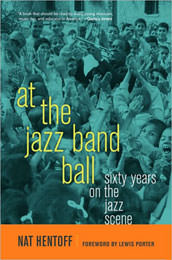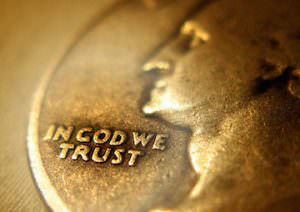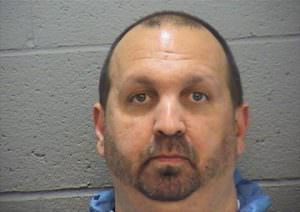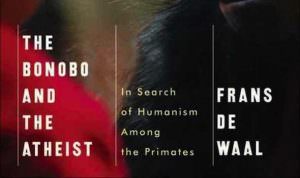Larry Blumenfeld on Nat Hentoff
A new collection of writings by one of America’s greatest self-described Jewish atheists distills the essence of his half-century defense of civil liberties and jazz -- the nation’s most original and influential art.A new collection of writings distills the essence of Hentoff's half-century defense of civil liberties and jazz -- America’s most original art.
The most resonant voice in the pages of “At the Jazz Band Ball: Sixty Years on the Jazz Scene,” the new collection of writings on jazz by Nat Hentoff, is that of the chazan — the cantor in the Orthodox Jewish synagogue Hentoff attended while growing up in Boston. It’s not that Hentoff is or was a particularly observant Jew (he calls himself “a Jewish atheist” in this book). But in shul, he found a captivating voice that provoked both visceral and intellectual responses that turned his head around, and that have lasted a lifetime.
“[T]he passionate, mesmerizing, often improvisatory singing of the chazan …, ” he writes, “sounded at times as if he were arguing with God.” At 11, when Hentoff heard “music blaring from a record store that made me shout aloud in pleasure” it was clarinetist Artie Shaw’s “Nightmare.” And though that particular keening A-minor melody of Shaw’s may in fact have been based on a cantorial theme (or so Hentoff says), a deeper connection with the music Hentoff would come to love and document — jazz — was thus forged. The cantor’s “soul cry of human promise, transcendence and vulnerability” was the same element Hentoff would home in on within the music of, say, Charles Mingus; his “depth of his witnessing to the human condition” an unbroken link for Hentoff to the blues at jazz’s base.
At the Jazz Band Ball: Sixty Years on the Jazz Scene
By Nat Hentoff
University of California Press, 272 pages
Hentoff likes to say he was an “itinerant subversive” from the beginning. Growing up in a then predominantly Jewish Roxbury neighborhood within an otherwise largely anti-Semitic Boston, he grew defiantly individual and developed a strong sense of social justice while still quite young. In his memoir, “Boston Boy,” he recalled his defining moment of rebellion at age 12 — eating a large salami sandwich on Yom Kippur, a day of fasting and atonement, while sitting on his family’s porch. He enjoyed not so much “that awful sandwich” as the experience of rebellion, combined with the knowledge of “how it felt to be an outcast.”
Hentoff has long channeled those sensibilities into what he calls his “day job — reporting on keeping the Bill of Rights alive,” reflected most prominently through his 50-year tenure as a columnist for The Village Voice and via his books. And those feelings have fueled his chosen labor of love: documenting and otherwise propagating jazz. The two endeavors dovetailed from the start. Hentoff, who was born in 1925, has lived through a good chunk of jazz’s history, including its heyday within American popular culture. He moved to New York to work as an editor for Down Beat magazine, which back then appealed to a much broader readership than it does today. In 1957, together with critic Whitney Balliett, he cast “The Sound of Jazz,” a landmark CBS program that brought the likes of Billie Holiday and Lester Young into American living rooms (Hentoff calls making that show “the most important thing I’ve ever done” — hyperbole, but also cause to consider the program’s impact). He wrote liner notes to groundbreaking recordings, including John Coltrane’s “Expressions” and Miles Davis’ “Sketches of Spain,” befriended musicians such as Dizzy Gillespie, Charles Mingus and Thelonious Monk, and produced some true classics, including “We Insist! Max Roach’s Freedom Now Suite.” Among his many books on jazz, 1955’s “Hear Me Talkin’ to Ya” (written with Nat Shapiro) was an early attempt to let musicians tell their own stories.
Hentoff is neither the first nor the last jazz lover to exalt the music as both metaphor and laboratory for whatever we mean when we speak of an American experiment. Ralph Ellison expressed all that with more literary distinction and greater connection to the context of African-American arts. But if Ken Burns’ 19-hour PBS series “Jazz” in 2000 offered something of a caricature of jazz as the symbol of American values and virtues, Hentoff’s body of writings has come closest to painting an honest working portrait of the idea. This comes clear when he describes momentous events, such as the making of the “Freedom Now!” suite, but just as well when he writes of fifth-graders in Sarasota, Fla., where a jazz organization convinced a public school system to teach history of jazz alongside American history. (“These little kids think Coltrane is cool,” he writes.) And if Hentoff lays it on a bit too heavy in discussing “the life force of jazz across the world, resisting banning even within Nazi Germany and Stalin’s Russia,” he’s also got disarming anecdotes like this one, about Charles Delaunay, who founded France’s Jazz Hot magazine:
|
To go to Google Books to see long excerpts from “At the Jazz Band Ball,” click here. |
“During World War II, while working undercover in Paris for the Free French, Charles was picked up by the Gestapo and taken in for interrogation. As the questioning was about to start, as SS officer looked hard at Delaunay and referred accusingly to a Fletcher Henderson record from the 1920s. ‘You didn’t have all the right personnel on that date,’ he said to Charles. Delaunay was not held for long.”
Chapter 10 of Hentoff’s book, “Is Jazz Black Music?” draws its question from the title of a “Jazz at Lincoln Center” panel discussion in which he participated. Hentoff could have — should have — delved more deeply into the implications of this question, not to mention what would constitute a satisfactory answer. And yet, here and there, he hints admirably at the complexity of the issue and the multiplicity of jazz’s responses. He writes early on about how trumpeter Clark Terry (who emerges as one clear hero throughout the book) walked away from a Harlem music education program he’d established when students refused to work with white teachers. He acknowledges the presence within jazz’s ranks of “reverse racism, as when Miles Davis was sharply criticized by some black musicians for hiring white pianist Bill Evans.”And Hentoff takes up the perhaps tougher and certainly less popular issue of gender bias. Admitting “it took me too long to realize the vital creative force of women in jazz — instrumentalists, not only singers,” he notes that Wynton Marsalis has yet to select a female musician for the Jazz at Lincoln Center Orchestra he directs. “Since Wynton does have big ears, I remain puzzled at this omission,” he writes. “As a challenge (one I’ve issued the trumpeter before): why doesn’t he try a blind audition, for once?” It’s a challenge all the more pointed because Hentoff knows well the story of the bassist Art Davis, who filed a discrimination suit against the New York Philharmonic, and which some (including bassist Ron Carter, as revealed in an interview with Hentoff quoted later in the book) feel helped usher in the practice of blind auditions for symphony orchestras.
The subject of jazz education, especially as expressed through the many university jazz programs that have cropped up during the last two decades, gets two-sided consideration through the interviews included here. “It’s the only way,” says Clark Terry, about the mentorship and history offered through jazz studies programs. But saxophonist Phil Woods disagrees. “Let’s get jazz out of the schools and put it back on the streets where it belongs. You know what I mean?… Too many lawyers is a drag, but they always get a gig, but too many tenor players is uncontainable. I mean, there’s 3,000 tenor players a year for three gigs and two of them are playing for the door at a Ramada Inn playing Britney Spears medleys.”
At the Jazz Band Ball: Sixty Years on the Jazz Scene
By Nat Hentoff
University of California Press, 272 pages
The chazan of Hentoff’s childhood shows up again, twice, in ways that pay off nicely in narrative terms: when Hentoff discovers that the great pianist Willie “The Lion” Smith studied Talmud and became a cantor himself in a Harlem synagogue; and when he reads a piece in The New York Times, part of a series in which critic Ben Ratliff asked jazz musicians to pick musical selections to share and discuss, and saxophonist Ornette Coleman chooses a 1916 recording by cantor Josef Rosenblatt. There’s cultural history revealed in these moments, but they’re more valuable for the author’s sheer joy.
Given the power of Hentoff’s focus, the fascinating insider life he’s led, and the wealth of information collected here, the presentation of this collection — drawn from a rage of previously published pieces — does not rise to the level of its contents. When, after 60 pages of first-person narrative, the introduction to an interview drawn from JazzTimes magazine refers to “veteran journalist Nat Hentoff,” it’s jarring, and not in a good way. And it’s interesting to learn — the first time, but not the third — that drummer Roy Haynes used to listen to Hentoff’s jazz radio show when he was a kid. Likewise even for the revelation upon hearing the chazan, rendered thrice in oddly overlapping fashion.
And yet some repetitions in this book function like a saxophonist returning to his theme again and again within a solo, refining his point. The most potent of these is Hentoff’s commitment to his role as what critic Gary Giddins has called “a chronicler.” In one of the book’s more fascinating essays, Hentoff cites Don Heckman’s negative review in the Los Angeles Times of one of his previous books, the main criticism of which was his “emphasis on the personality of the artist rather than the process” (read: a lack of critical or musicological analysis). At one point, Hentoff admits to sometimes “feeling fraudulent” for lack of knowledge about, say, chord substitutions. That feeling grew more intense when his daughter, then a budding musician, asked: “How can you dare affect the income of a musician when you give him bad reviews since you can’t say technically what you think he’s doing wrong?”
Hentoff cuts to an encounter with the arranger Gil Evans. “I’ve been reading you for years,” Evans said, “so I know what you listen to and how you listen. I also know musicians who can tell technically everything that’s going on in a performance, but they don’t get into where this music is coming from inside the musician — the story he wants to tell. You can do that some of the time. Stop worrying.”
Hentoff either stopped worrying, or went ahead anyway. Without discounting the value of or need for such critical analysis based on musical knowledge — how could he? — he argues for the narrative of jazz as a succession of stories of men and women who have shaped and lived the music, and does so effectively. And yet — well, Nat, you needn’t. By now, you rate as one of those men. And you documented each step, in a prayerful way.
Larry Blumenfeld writes on jazz for numerous publications, including The Wall Street Journal.
Your support matters…Independent journalism is under threat and overshadowed by heavily funded mainstream media.
You can help level the playing field. Become a member.
Your tax-deductible contribution keeps us digging beneath the headlines to give you thought-provoking, investigative reporting and analysis that unearths what's really happening- without compromise.
Give today to support our courageous, independent journalists.






You need to be a supporter to comment.
There are currently no responses to this article.
Be the first to respond.